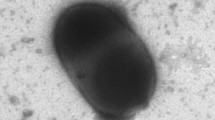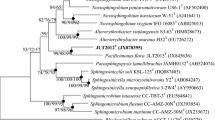Abstract
A novel rod-shaped binary fission, and yellow-pigmented bacterial strain, JLT 2480T, was isolated from surface seawater in the East Pacific Ocean. The strain is Gram negative and oxidase negative. Phylogenetic analyses based on 16S rRNA gene sequence indicate that strain JLT 2480T falls in the family Sphingomonadaceae, sharing highest similarity (95.6 %) with the species Blastomonas ursincola. The DNA G+C content of JLT 2480T is 65.5 mol%, and the sole respiratory quinone is coenzyme Q10. The predominant polar lipids are sphingoglycolipids (SGL1 and SGL2), phosphatidylglycerols, phosphatidylethanolamines, phospholipids, glycolipids, and phosphatidylcholines. The predominant cellular fatty acids are C16:0, C18:0, C18:1ω7c, C12:0, and C16:1ω7c. Strain JLT 2480T is distinct from the B. ursincola type strain DSM 9006T as reflected by major chemotaxonomic distinctions between the two. Furthermore, two notable characteristics of the genus Blastomonas, that is, the presence of bacteriochlorophyll a and the puf genes, are not detected in JLT 2480T. On the basis of present evidence, we consider JLT 2480T to be a novel species in a new genus of the family Sphingomonadaceae, and propose the name Binariimonas pacifica gen. nov., sp. nov., with strain JLT 2480T (=CGMCC 1.12850T = DSM 28646T) to be the type strain for genus Binariimonas.


Similar content being viewed by others
References
Choi TE, Liu QM, Yang JE, Sun S, Kim SY, Yi TH, Im WT (2010) Sphingomonas ginsenosidimutans sp. nov., with ginsenoside converting activity. J Microbiol 48(6):760–766. doi:10.1007/s12275-010-0469-z
Doetsch RN (1981) Determinative methods of light microscopy. In: Gerhardt P et al. (ed) Manual of methods for general bacteriology. ASM, Washington, p 21–33
Embley TM (1991) The linear PCR reaction: a simple and robust method for sequencing amplified rRNA genes. Lett Appl Microbiol 13:171–174. doi:10.1111/j.1472-765X.1991.tb00600.x
Hiraishi A, Kuraishi H, Kawahara K (2000) Emendation of the description of Blastomonas natatoria (Sly 1985) Sly and Cahill 1997 as an aerobic photosynthetic bacterium and reclassification of Erythromonas ursincola Yurkov et al. 1997 as Blastomonas ursincola comb. nov. Int J Syst Evol Microbiol 50(3):1113–1118. doi:10.1099/00207713-50-3-1113
Kämpfer P, Denner EBM, Meyer S, Moore ERB, Busse HJ (1997) Classification of “Pseudomonas azotocolligans” Anderson 1955, 132, in the Genus Sphingomonas as Sphingomonas trueperi sp. nov. Int J Syst Evol Microbiol 47(2):577–583. doi:10.1099/00207713-47-2-577
Kämpfer P, Witzenberger R, Denner EBM, Busse HJ, Neef A (2002) Novosphingobium hassiacum sp. nov., a new species isolated from an aerated sewage pond. Syst Appl Microbiol 25:37–45. doi:10.1078/0723-2020-00083
Kämpfer P, Arun AB, Young CC, Busse HJ, Kassmannhuber J, Rosselló-Móra R, Geueke B, Rekha PD, Chen WM (2012) Sphingomicrobium lutaoense gen. nov., sp. nov., isolated from a coastal hot spring. Int J Syst Evol Microbiol 62(6):1326–1330. doi:10.1099/ijs.0.034413-0
Kolber ZS, Van Dover CL, Niederman RA, Falkowski PG (2000) Bacterial photosynthesis in surface waters of the open ocean. Nature 407:177–179. doi:10.1038/35025044
Komagata K, Suzuki KI (1988) 4 lipid and cell-wall analysis in bacterial systematics. Methods Microbiol 19:161–207. doi:10.1016/S0580-9517(08)70410-0
Kosako Y, Yabuuchi E, Naka T, Fujiwara N, Kobayashi K (2000) Proposal of Sphingomonadaceae fam. nov., consisting of Sphingomonas Yabuuchi et al. 1990, Erythrobacter Shiba and Shimidu 1982, Erythromicrobium Yurkov et al. 1994, Porphyrobacter Fuerst et al. 1993, Zymomonas Kluyver and van Niel 1936, and Sandaracinobacter Yurkov et al. 1997, with the type genus Sphingomonas Yabuuchi et al. 1990. Microbiol Immunol 44(7):563–575. doi:10.1111/j.1348-0421.2000.tb02535.x
Lee M, Ten LN, Lee HW, Oh HW, Im WT, Lee ST (2008) Sphingopyxis ginsengisoli sp. nov., isolated from soil of a ginseng field in South Korea. Int J Syst Evolut Microbiol 58(10):2342–2347. doi:10.1099/ijs.0.64431-0
Mao YJ, Wei JJ, Zheng Q et al (2012) Roseibacterium beibuensis sp. nov., a novel member of Roseobacter clade isolated from Beibu Gulf in the South China Sea. Curr Microbiol 65(5):568–574. doi:10.1007/s00284-012-0192-6
Mesbah M, Whitman WB (1989) Measurement of deoxyguanosine/thymidine ratios in complex mixtures by high-performance liquid chromatography for determination of the mole percentage guanine+cytosine of DNA. J Chromatogr A 479:297–306. doi:10.1016/S0021-9673(01)83344-6
Nagashima KVP, Hiraishi A, Shimada K, Matsuura K (1997) Horizontal transfer of genes coding for the photosynthetic reaction centers of purple bacteria. J Mol Evol 45(2):131–136. doi:10.1007/PL00006212
Sasser M (1990) Identification of bacteria by gas chromatography of cellular fatty acids. http://natasha.eng.usf.edu/gilbert/courses/Biotransport%20Phenomena/pdf/bacteria_gc_1.pdf
Shahina M, Hameed A, Lin SY, Hsu YH, Liu YC, Huang YM, Lin JC, Young CC (2013) Sphingomicrobium marinum sp. nov. and Sphingomicrobium flavum sp. nov., isolated from surface seawater, and emended description of the genus Sphingomicrobium. Int J Syst Evol Microbiol 63(12):4469–4476. doi:10.1099/ijs.0.052837-0
Sly LI (1985) Emendation of the Genus Blastobacter Zavarzin 1961 and description of Blastobacter natatorium sp. nov. Int J Syst Bacteriol 35(1):40–45. doi:10.1099/00207713-35-1-40
Sly LI, Cahill MM (1997) Transfer of Blastobacter natatorius (Sly 1985) to the Genus Blastomonas gen. nov. as Blastomonas natatoria comb. nov. Int J Syst Bacteriol 47(2):566–568. doi:10.1099/00207713-47-2-566
Srinivasan S, Kim MK, Sathiyaraj G, Veena V, Mahalakshmi M, Kalaiselvi S, Kim YJ, Yang DC (2010) Sphingopyxis panaciterrulae sp. nov., isolated from soil of a ginseng field. Int J Syst Evol Microbiol 60(10):2358–2363. doi:10.1099/ijs.0.019414-0
Takeuchi M, Hamana K, Hiraishi A (2001) Proposal of the genus Sphingomonas sensu stricto and three new genera, Sphingobium, Novosphingobium and Sphingopyxis, on the basis of phylogenetic and chemotaxonomic analyses. Int J Syst Evol Microbiol 51(4):1405–1417. doi:10.1099/00207713-51-4-1405
Tamaoka J, Komagata K (1984) Determination of DNA base composition by reversed-phase high-performance liquid chromatography. FEMS Microbiol Lett 25(1):125–128. doi:10.1111/j.1574-6968.1984.tb01388.x
Xiao N, Liu Y, Liu X, Gu Z, Jiao N, Liu H, Zhou Y, Shen L (2015) Blastomonas aquatica sp. nov., a bacteriochlorophyll-containing bacterium isolated from lake water on the Tibaten Plateau, China. Int J Syst Evolut Microbiol. doi:10.1099/ijs.0.000153
Yabuuchi E (2002) Correction of the connecting vowel and gender of the specific epithet in the name Sphingomonas macrogoltabidus Takeuchi et al. 1993 to Sphingomonas macrogolitabida. Int J Syst Evol Microbiol 52(3):1039. doi:10.1099/ijs.0.02051-0
Yabuuchi E, Yano I, Oyaizu H, Hashimoto Y, Ezaki T, Yamamoto H (1990) Proposals of Sphingomonas paucimobilis gen. nov. and comb. nov., Sphingomonas parapaucimobilis sp. nov., Sphingomonas yanoikuyae sp. nov., Sphingomonas adhaesiva sp. nov., Sphingomonas capsulata comb. nov., and two genospecies of the genus Sphingomonas. Microbiol Immunol 34(2):99–119. doi:10.1111/j.1348-0421.1990.tb00996.x
Yurkov VV, Krieger S, Stackebrandt E, Beatty JT (1999) Citromicrobium bathyomarinum, a novel aerobic bacterium isolated from deep-sea hydrothermal vent plume waters that contains photosynthetic pigment-protein complexes. J Bacteriol 181(15):4517–4525
Yurkov VV, Stackebrandt E, Buss O, Vermeglio A, Gorlenko V, Beatty JT (1997) Reorganization of the Genus Erythromicrobium: Description of “Erythromicrobium sibiricum” as Sandaracinobacter sibiricus gen. nov., sp. nov., and of “Erythromicrobium ursincola” as Erythromonas ursincola gen. nov., sp. nov. Int J Syst Evolut Microbiol 47(4):1172–1178. doi:10.1099/00207713-47-4-1172
Zheng Q, Chen C et al (2010) Mameliella alba gen. nov., sp. nov., a marine bacterium of the Roseobacter clade in the order Rhodobacterales. Int J Syst Evol Microbiol 60(4):953–957. doi:10.1099/ijs.0.011437-0
ZoBell CE (1941) Studies on marine bacteria. I. The cultural requirements of heterotrophic aerobes. J Mar Res 4:42–75
Acknowledgments
We thank the Pigmented Marine Bacteria Collection Center for assistance in our experiments. This study was supported by the 973 Program (2013CB955700, 2011CB808800), the SOA Project (GASI-03-01-02-05), and the NSFC (41376132).
Author information
Authors and Affiliations
Corresponding authors
Additional information
The GenBank/EMBL/DDBJ Accession number for the 16S rRNA gene sequence of strain JLT 2480T is KJ586578.
Electronic Supplementary Material
Below is the link to the electronic supplementary material.
Rights and permissions
About this article
Cite this article
Zhao, Z., Sun, J., Zhang, R. et al. Binariimonas pacifica gen. nov., sp. nov., a Novel Marine Bacterium of Family Sphingomonadaceae Isolated from East Pacific Ocean Surface Seawater. Curr Microbiol 72, 276–281 (2016). https://doi.org/10.1007/s00284-015-0948-x
Received:
Accepted:
Published:
Issue Date:
DOI: https://doi.org/10.1007/s00284-015-0948-x




